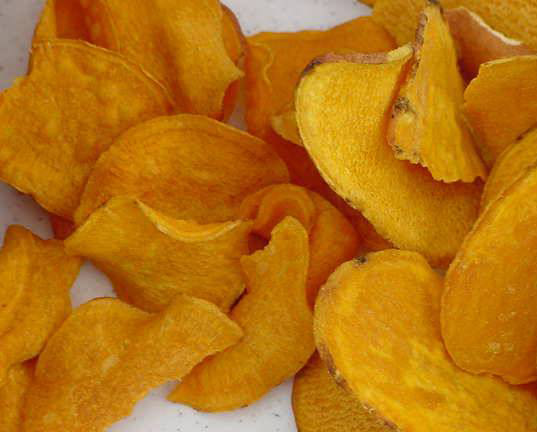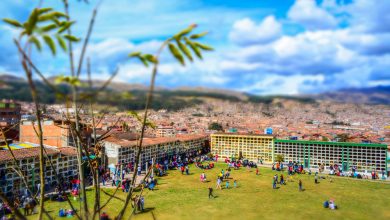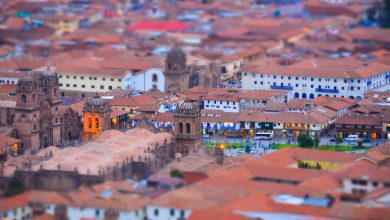Globe Trotting Sweet Potatoes

Boiled Sweet Potato
Everyone in the United States will eat something Peruvian this Thursday, though they may not know it.
It is hard to imagine US Thanksgiving without potatoes and sweet potatoes or yams as these last are strangely called in the United States. Both of these tubers originate in the Andes, though they have a strange history of expansion.
Potatoes are less strange than sweet potatoes. Somehow these tubers with bright colored flesh and wonderful sweet taste that grow under a vine left the Andes many times to make their way into the world.

Here is what is strange. Though they come from a broad region including South America and Central America, where grow the largest number of wild species, European explorers found them throughout the south Pacific. Somehow this amazing tuber jumped from the Andes to Polynesia and then Island hopped.
For a long time this situation has perplexed both botanists and archeologists. There just was no good evidence to explain it and to show how it happened, though lots of people made lots of conjecture.
A team of researchers from France claim to have solved this intellectual and historical puzzle. This might just be a great conversation tidbit for your Thanksgiving dinner or other event.
Some facts first.
The sweet potato was one of the world’s oldest food crops, found by archeologists in Peru some 8-10,000 years ago.
The sweet potato was already in Polynesia before the Europeans could have brought it there.
The Aztec word for sweet potato, camotli, in its Spanish variant, camote, is the word used throughout Peru to describe this delicious tuber, although the lowland Quechua word, kumara, in one derivative or another is used throughout Polynesia.
The Sweet potato was classically confused with the potato, also from the Andes, when they both arrived in Europe. We get our word, potato, from the Taino batata. These people were some of the first Columbus met in his explorations.

The sweet potato came to New England some time in the early 1700s, a little late for the first Thanksgiving but still early enough to become thoroughly naturalized as an American crop.
Back to the problem of Polynesia and its relationship with South America as manifested in Sweet potatoes.
The French team looked carefully at collections of sweet potatoes to find historical varieties and then extracted genes in order to test what they called the tripartite hypothesis. Their evidence supported it.
They posit sweet potatoes first came to Polynesia from South America between 1000 and 1100 AD, about a thousand years ago. The ocean voyagers who brought back the sweet potato rapidly spread it throughout Polynesia, from Hawaii to Aotearoa (New Zealand) and everywhere in between. The researchers call this the kumara line.
Next, Spanish explorers brought the sweet potato into the Pacific, especially the Philippines, from Mexico and Central America around 1520. From their it spread outward into other parts of he Eastern Pacific. The researchers call this the camote line.
Finally, the Portuguese brought a different line from the Caribbean through shipping via Africa and the Moluccas about 1500 into Indonesia and New Guinea. This line, the researchers call the batata or aje line. (One version or another of ahe—as ahi would be pronounced in English, was used by South Eastern Indians in what became the United States to describe the Sweet Potatoes they obtained by the seventeenth century).

The authors conclude that the evidence is clear. The earliest sweet potatoes in the very complex genetic pool that has become Polynesia are from South America. Not only do they carry a Quechua name, they also carry genes that demonstrably come from the Andes.
In any case, this bright and sweet tuber has an amazing history. After it was first domesticated somewhere in the Andean region, it spread to Central America and Mexico, as well as into the Caribbean and Polynesia. It also looks to have made its way into fields of the South Eastern US.
Later, the Spanish and Portuguese explorers spread the crop again, marked by the names camote and batata. It appears, based on this language evidence, that New Englanders got the sweet potato or yam from the Portuguese somehow. Evidently, the domestic turkey we Americans also eat at Thanksgiving, also came through Lisbon.
In any case, as you enjoy a spoonful of sweet potatoes as well as one of mashed potatoes and gravy know that at the base of the these fabled food’s history is Peru.
References:
Caroline Roullier, Laure Benoit, Doyle B. McKey, and Vincent Lebot, “Historical collections reveal patterns of diffusion of sweet potato in Oceania obscured by modern plant movements and recombination”, PNAS, February 5, 2013, vol. 110, no. 6, 2205–2210.
Daniel F. Austin, “The Taxonomy, Evolution, and Genetic Diversity of Sweet Potatoes and Related Wild Species”, Exploration, Maintenance, and Utilization of Sweet Potato Genetic Resources, International Potato Center, Lima Peru, 1989. http://pdf.usaid.gov/pdf_docs/PNAAZ952.pdf
Dan Jurafsky, The Language of Food, A Linguist Reads the Menu (W.W. Norton and Company, 2014)





